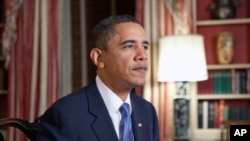Nearly 20 per cent of President Obama's budget for the next fiscal year, presented to the Congress Monday, is a request for $708 billion for the Department of Defense. Even at a time of economic downturn and plans for a spending freeze on many government programs, that is an increase of 3.4% over the current defense budget, 1.8% after inflation. It is the largest U.S. defense budget ever, but the increase from the current year is well below the 4% average annual increase of the past decade. VOA reports from the Pentagon on how officials plan to spend the money.
The Pentagon budget, and two accompanying strategy reviews, lay out a plan that puts a high priority on winning the wars in Iraq and Afghanistan, and being ready to fight and win any future conflicts against global or regional powers, or against terrorist groups, or conflicts in space or cyberspace. The documents also call for an increase in missile defense capability to defend against increasingly flexible, mobile, reliable, accurate and long range missiles being developed or obtained by several countries, including Iran and North Korea.
Speaking as the plan was released, U.S. Defense Secretary Robert Gates said the goal of the policy reviews and budget proposals is to enable the U.S. military to prevail in the current wars and prepare for a risky and uncertain future.
"We have, in a sober and clear-eyed way, assessed risk, set priorities, made trade-offs and identified requirements based on plausible real-world threats, scenarios and potential adversaries," said Robert Gates.
The main policy document published Monday, the Quadrennial Defense Review, is designed to set the Defense Department's direction for the next four years. It cites an increasingly complex global security environment, in which what it calls "non-state actors" - meaning terrorist groups - have access to more and more lethal and long-range technologies. It also cites the potential proliferation of weapons of mass destruction and the potential disruption caused by cyber attacks as critical concerns. And the document says policy makers are increasing concerned about what it calls "powerful trends...likely to add complexity to the security environment," including rising demand for resources, urbanization, climate change, new strains of disease and "profound cultural and demographic tensions."
The Review says the United States must maintain "unmatched capabilities and a willingness" to use them when deterrence efforts fail. But Secretary Gates noted that the plan also calls for more cooperation with the State Department and other agencies to promote stability, resolve conflicts and build the capacity of other nations to provide for their own defenses, in order to try to prevent wars.
"Both we and State see this as an area of real opportunity to try and prevent wars from happening, rather than having to deal with them once they've already started," he said.
The Quadrennial Defense Review says the U.S. military must maintain the ability to fight two major wars, which has been its requirement for many years, but must also develop and maintain the ability to fight smaller wars against multiple overseas adversaries, and also to protect the U.S. homeland and respond to natural disasters at home and abroad. The document warns that missions may well occur "in multiple and unpredictable combinations." Secretary Gates put some emphasis on the 'unpredictable' aspect in explaining his department's request for broad and varied capabilities.
"We have learned through painful experience that the wars we fight are seldom the wars we planned," said Gates. "As a result, the United States needs a broad portfolio of military capabilities, with maximum versatility across the widest spectrum of conflict."
Monday's documents also acknowledge that the all-volunteer U.S. military has been "significantly stressed" by the wars in Iraq and Afghanistan, and other global commitments. It calls for policies and spending to support the troops, their families and veterans.
Regarding specific capabilities for today's fights, the budget and the review both call for more armored vehicles, helicopters and unmanned aircraft, along with more special operations forces, increased capability for counterinsurgency and stability operations, and more regional expertise related to Afghanistan and Pakistan. The president also submitted a request for an additional $33 billion for the current year to fund his plan to send 30,000 additional troops to Afghanistan.








